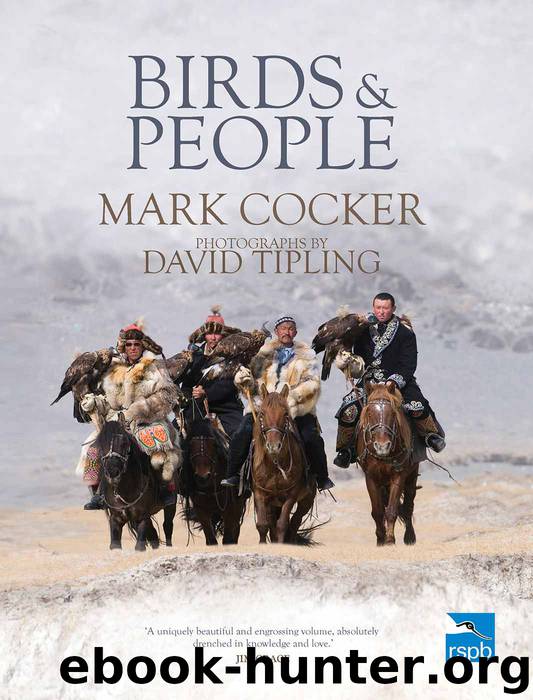Birds and People by Mark Cocker

Author:Mark Cocker [Cocker, Mark]
Language: eng
Format: azw3
Publisher: Random House
Published: 2014-03-17T04:00:00+00:00
HUMMINGBIRDS IN PRE-COLUMBIAN MYTH
One of the striking things about almost all cultural portrayals of hummingbirds is that they honour this miraculous quality in their lives. The birds are writ large in the mythologies and story cycles of almost all those pre-Columbian peoples with whose range the birds overlapped. One can only cover a sample of this huge corpus of cultural association but in many a common thread is at work.
For the Akimel O’odham (Pima) people of southern Arizona and Mexico, a hummingbird came to the rescue of their ancestors in a time of severe drought. The bird twisted a magic thong around the rain and wind spirits, which had taken refuge in a hidden cave, and led them back to the supplicant and desperate people. Thereafter the hummingbird pledged that he and the rains and wind would all return to the O’odham lands together at the same season.
This linkage of hummingbirds with the coming of rain (and, thus, fertility) is found across much of the arid southwest region of the USA, most notably among the Hopi, Zuni and other Pueblo groups.9 For their near-neighbours the Navaho, if not a bringer of rain, then the hummingbird was a bearer of food. One of their own origin myths described how the bird – one of four totem animals – brought them their corn with multicoloured grains.10 Perhaps even more compelling, for its deep parallels to these North American tales, is a Yahgan story from Chile’s Tierra del Fuego. In this the Green-backed Firecrown Sephanoides sephaniodes (Sámakéär or Omora in their language), the most southerly distributed of all its family, causes the mountain streams to flow and relieve the drought-stricken Yahgan.11
Another strand of stories that spanned a range of geographically associated cultures linked hummingbirds with tobacco. Rather than the abhorrent carcinogen that it is to modern society, tobacco had an almost sacred status for pre-Columbian peoples. Its use was framed within and mediated by a cradle of ritual, and the nicotine-rich leaves were hugely valued for their magico-medicinal properties, especially their trance-inducing power (see also Parrots and Amerindians). Along the northern coastline of South America (now Venezuela and Guyana) the Carib, Arawak and Warao peoples shared a myth that they had received the plant from hummingbirds. It is striking that the Cherokee, once located at the northern limit of its indigenous cultivation (in south-eastern USA), similarly honoured the hummingbird as a bringer of this gift.12 For some communities the issues of rain, fertility and tobacco all subtly intermeshed. In order to induce the rains, Pueblo Indians would blow tobacco smoke to the four directions to summon those other moisture-bearing clouds.13
In all of the stories one can surmise a real-life context that underpinned the hummingbird associations. For North American peoples the birds are migrants that largely arrive in spring. They were ever likely, therefore, to carry with them connections to fertility or new life. Similarly the long tubular flowers of plants in the genus Nicotiana, from which tobacco is derived, are favourite sources of nectar for hummingbirds.
Download
This site does not store any files on its server. We only index and link to content provided by other sites. Please contact the content providers to delete copyright contents if any and email us, we'll remove relevant links or contents immediately.
Sapiens: A Brief History of Humankind by Yuval Noah Harari(14172)
The Tidewater Tales by John Barth(12584)
Mastermind: How to Think Like Sherlock Holmes by Maria Konnikova(7175)
Do No Harm Stories of Life, Death and Brain Surgery by Henry Marsh(6845)
The Thirst by Nesbo Jo(6770)
Why We Sleep: Unlocking the Power of Sleep and Dreams by Matthew Walker(6566)
Life 3.0: Being Human in the Age of Artificial Intelligence by Tegmark Max(5410)
Sapiens by Yuval Noah Harari(5270)
The Longevity Diet by Valter Longo(4999)
The Body: A Guide for Occupants by Bill Bryson(4895)
The Rules Do Not Apply by Ariel Levy(4797)
The Immortal Life of Henrietta Lacks by Rebecca Skloot(4456)
Animal Frequency by Melissa Alvarez(4370)
Why We Sleep by Matthew Walker(4322)
The Hacking of the American Mind by Robert H. Lustig(4271)
Yoga Anatomy by Kaminoff Leslie(4253)
All Creatures Great and Small by James Herriot(4197)
Double Down (Diary of a Wimpy Kid Book 11) by Jeff Kinney(4153)
Barron's AP Biology by Goldberg M.S. Deborah T(4069)
